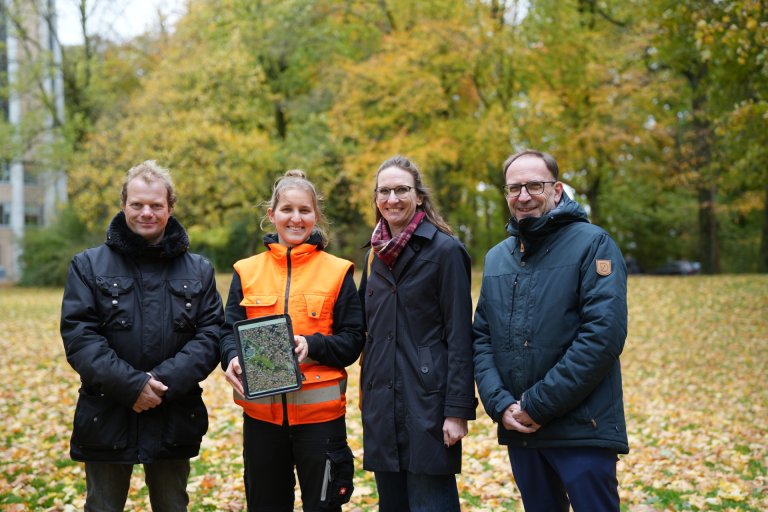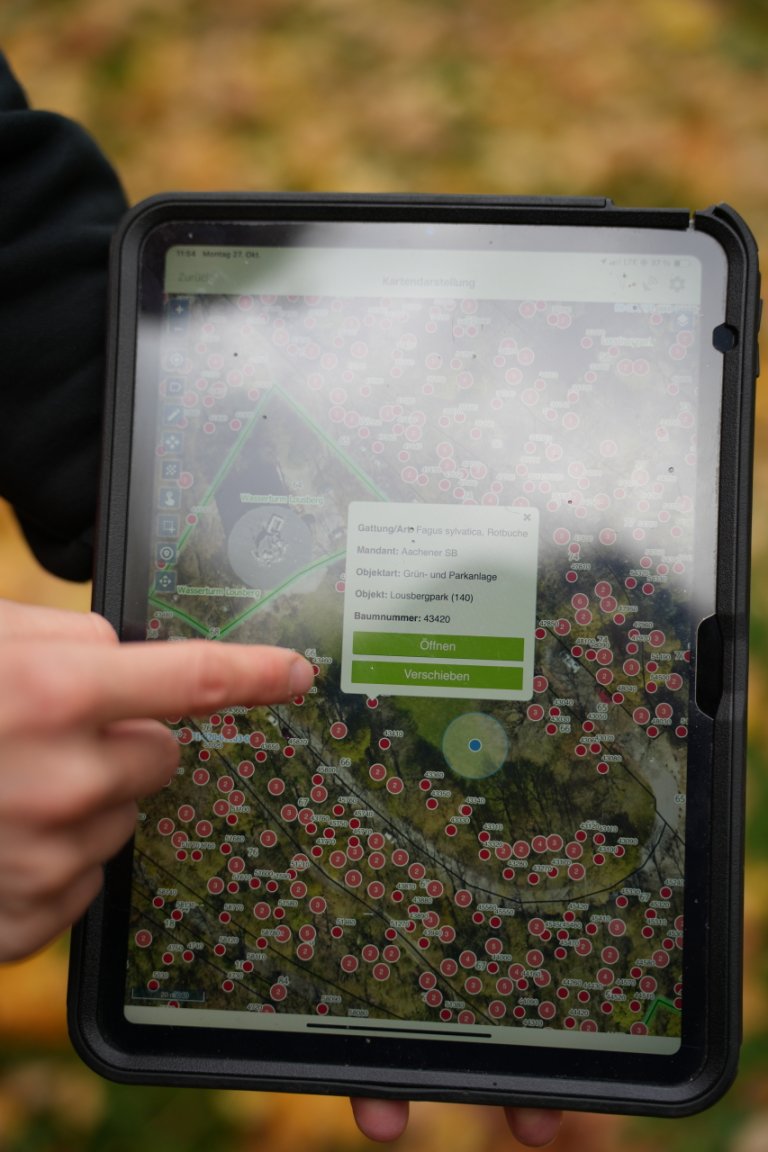125,014 tree locations are recorded in the tree register
- With the help of the tree register, all 125,014 street trees in Aachen were cataloged.
- Nine specially trained tree inspectors created a file for each tree.
- In this way, the development of each tree can be precisely documented over many years.
Yasemin Güster enters the last data of the maple tree on the Lousberg into the tree register. Some deadwood can be seen in the tree. "That's damage that we're recording," she explains. Yasemin Güster is the foreman of the tree inspection team and one of nine tree inspectors in the tree maintenance team at Aachen's municipal utility company. The recorded data is entered into the tree register. This data is then evaluated by colleagues in the planning department, in collaboration with the relevant team leader, and later processed by the tree maintenance teams.
"The care and preservation of our city trees is essential. After all, Aachen depends to a large extent on our greenery. In addition, city trees can cool the air by several degrees during hot spells. It is therefore all the more important that we have an overview of the stock," says Heiko Thomas, Councillor for Climate, City Operations and Buildings, explaining the importance of the tree register.
The initial recording of the trees in the tree register began in December 2018 - at that time still on paper, as Maurice Vonhoegen, team leader of the city's tree inspection department, explains. The first recorded tree is a hornbeam in Maria-Theresia-Allee, which is now around 50 years old and around 13 meters high.
The tree register records what Maurice Vonhoegen calls the tree's identity card, including master data such as tree species, location, age, tree height, crown and trunk diameter and vitality. The other data recorded is the condition data, the so-called "patient file". This records the condition of the tree, such as the condition of the crown, trunk, bark, root system and tree environment. Possible diseases, wounds, fungal infestation, stability and other information about the tree's state of health are then added. The paper file has now given way to digital recording. This is because: "All this information is now entered quickly and clearly into the program on a mobile device and can be accessed immediately by everyone. As a result, we can also pass on work orders to the tree care team directly in the tree register and determine long-term measures - in other words, we can monitor every tree," says Vonhoegen.
The tree inspectors have been recording the trees in Aachen for more than eight years as part of the initial recording in the tree register. Having started with three inspectors, the team has now grown to nine experts. "We have specialist staff with a very high level of knowledge," says Maurice Vonhoegen. The team has undergone numerous additional training courses in recent years. City operations manager Indra Balsam adds: "A total of 50 colleagues are entrusted with tree care, inspection and maintenance. We are actively working to ensure that they all attend regular training courses. This enables us to ensure that our city trees are protected with a high level of expertise."
The speed at which the trained experts are now working is enormous. Within a few minutes, they have recorded all the data on a tree. "Initially, we assumed there were around 100,000 street trees. Now, thanks to the tree register, we know that there are 125,014 trees in the city," says Maurice Vonhoegen.
Nine-month control interval
The inspectors began by checking the trees at daycare centers, schools, playgrounds and sports grounds. This was gradually followed by the main roads in the city center, the ring roads and the major arterial roads. However, this is only the first step. The main aim of the tree register is to make the entire work of tree inspection and maintenance easier. Every nine months, each individual tree, each "patient", is checked. This also ensures that the tree has been inspected once every season after four inspection dates.
If the examination reveals that a measure is necessary, a note is issued immediately. Classified into four levels of urgency, it is determined whether an immediate measure must be taken or whether a new assessment in two months or at the normal inspection interval is sufficient. "A second opinion is needed for questionable matters," adds Andreas Schulz, Head of Tree Maintenance at Aachen City Council. The tree is then examined more closely during a further tree inspection - a visit by a specialist. With the help of a cherry picker, for example, the crown of the tree can be viewed up close.
Becoming part of the tree maintenance team is possible: More at karriere.aachen.de.
You can subscribe to our RSS feed for our press releases here https://www.aachen.de/rss-feed-pressemitteilungen/rss.xml


